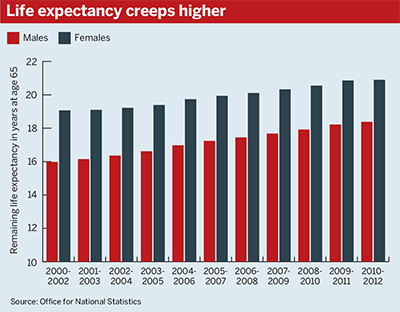Adhesive tape manufacturer Scapa has reduced its defined benefit liability by £4m, having undertaken a mortality study across its pensioner population as part of a holistic approach to managing risk across the scheme’s assets and long-term obligations.
Liability management has continued as a major theme in 2016 after a bumper year of transactions in 2015.
New business in the medically underwritten bulk annuity market more than doubled last year to over £1.2bn, up from £540m in 2014, according to research from JLT Employee Benefits.
There is no silver bullet for pensions – it consists of lots of small liability management exercises, coupled with an asset strategy
Paul Edwards, Scapa
As part of this upsurge, a number of specialist mortality propositions have developed, allowing trustees and scheme sponsors to more accurately chart the forward trajectory for liabilities, armed with enhanced insight of their members’ health and lifestyle.
In the past six months, Bedford-based Scapa Group has reduced its DB liability by £4m after completing a mortality study across its scheme membership.
Paul Edwards, finance director at Scapa, said the study had provided a better understanding of the scheme’s liabilities.
“We came to the conclusion that only 20 per cent of our pensioners are actually senile, [which] enabled us to accurately reflect that within the scheme [valuation],” he said.
Coupled with a flexible retirement option, offered to members in 2014, and a £6m boost through strong asset returns over the past year, Scapa’s approach to managing risk within its £140m scheme targets both assets and liabilities.
Working with consultancy Mercer, trustees have implemented derisking triggers within the scheme to help limit the impact of volatility.
Edwards said the strategy “has worked very well”, adding that the company took a broad approach to managing scheme risk.
“There is no silver bullet for pensions – it consists of lots of small liability management exercises, coupled with an asset strategy,” said Edwards.
“Everyone manages their assets in a business, but actually the liabilities need managing just as much; people tend to ignore [that].”

Mortality assumptions
Ruth Ward, senior consultant at JLT Employee Benefits, said medical data is increasingly being used to underwrite bulk annuity transactions, but can also be used as an additional tool to improve the accuracy of assumptions used in scheme valuations.
“As a trustee, if you thought there was a danger you might be under-reserving for the true scheme funding liabilities, it might be something you want to look at, but equally you could just strengthen the assumptions you were using,” said Ward, adding that sponsors may hold a view “the other way” and believe trustees are too conservative in their assumptions.
“By getting more information you might get to a position where you’re both more comfortable that you’re holding the right amount,” she said.
“Obviously once you’ve collected that information, if you did go to market you would have to declare that to insurers.”
Paul Darlow, head of proposition development at consultancy Xafinity, said the key uncertainty in mortality assumptions is how the picture will change.
“Mortality studies are not really of much use in helping you to determine how you think mortality is going to change in the future – they only really look at what your mortality is today,” he said.
Many pension schemes already have a “relatively high degree of confidence” on current mortality assumptions, Darlow said, adding that one extra piece of information is unlikely to make a big difference.
“It does come with the drawback that if you gather this information and then you try to buy in or buy out some of your liabilities in the future, it does limit your insurance options,” he said.














